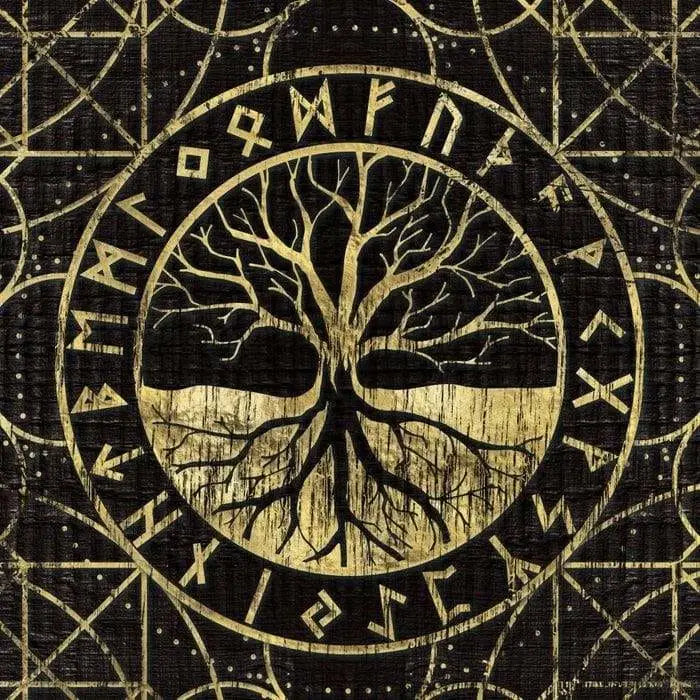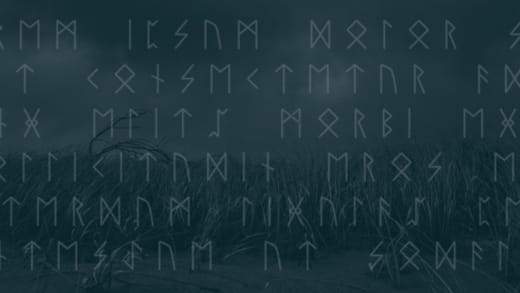Almost as famous as the Viking warriors are the Nordic runes, these epic, tranquil symbols have a real feel of magic about them. Even modern Viking use them as tattoos.
Indeed, the Vikings themselves thought that these symbols, that they also used for the mundane such as commerce and politics, carried magical powers.
Read on to learn more about the origins of the Nordic runes, the meanings of individual runes, and how the Vikings used the runes.
Nordic Runes Origins

Discover some awesome gifts from our Viking store. The word rune comes from the Germanic word run, which means secret or whisper. According to Norse mythology it was Odin, king of the gods, and god of wisdom and war, that gained knowledge of the runes.
In this story from Norse mythology, he willingly hung himself from Yggdrasil, the Tree of Life, for nine days while pierced with his own spear in order to gain knowledge of the runes. He then shared that knowledge with mankind.
It is unclear from Norse mythology whether the runes simply came to him from a combination of the trauma of the ordeal and looking into the heart of the cosmos, or whether they were in some way sent up to him from the Well of Urd, which is located at the base of Yggdrasil.

According to Norse mythology, this is where the Norns (the fates in Norse Mythology) live, and they carve runes onto the Tree of Life itself in order to write the fates of men.
Linguists suggest that the runes were adopted by Northern Europeans from early Italic alphabets. The first Germanic rune alphabet, known as Elder Futhark, emerged in about the first century AD. This alphabet was certainly used in Scandinavia as a full set of the 24 runic symbols has been found on the Kylver stone in Sweden.
With the rise of the Vikings, Scandinavian languages began to change and Elder Futhark was replaced by Younger Futhark from about AD800.
This was a shorter alphabet of only 16 runic symbols, and there were three slightly different versions of the alphabet in Denmark, Norway and Sweden.
These runes were used until about AD1200, when they were completely replaced by Latin due to the influence of Christianity.
While few examples of Elder Futhark in use survive, Younger Futhark seems to have been used widely. More than 6,000 inscriptions using Younger Futhark symbols survive from around Scandinavia.
The runes were generally carved into stone, wood, bone, metal or other hard surfaces.
This probably explains the sharp straight lines of the alphabet, which would have been easier to inscribe on hard surfaces than rounded letters.
Nordic Rune Meanings
Like our own familiar alphabet, the runes symbolize sounds, that can be used to spell out different words.
They were used in this way for mundane notes and records as required. But each rune also had a philosophical and magical significance.

Below is a list of the names of the individual Norse runes and what those names mean in Old Norse. Also given are the sound associated with each rune, and the general significance of the rune.
These insights have all been garnered from rune poems documented from Iceland and Norway that provide a short description of each of the runes.
- Fé (cattle) – F – Wealth
- Ur (drizzle/slurry) – U – Strength of Will
- Thurs (giant) – Th – Danger, Suffering
- Óss (god/mouth) – O – Inspiration, Wisdom
- Raeidh (riding) – R – Movement, Work, Growth
- Kaun (wound) – K – Mortality, Pain
- Hagall (hail) – H – Destruction, Chaos
- Naudhr (need) – N – Need, Unfulfilled Desire
- Is (ice) – I – Destruction
- Ar (a good year) – A – Plenty, Good Harvest
- Sól (sun) – S – Solace
- Tyr (the god Tyr) – T – Victory, Honor
- Bjarkan (birch twig) – B – Fertility, Growth, Sustenance
- Madhr (man) – M – Augmentation, Support
- Logr (power of water) – L – Formlessness, Chaos
- Yr (yew tree bow) – Z – Endurance
Nordic Rune Magic
Check out our Viking beard beads. The Romans, observing pre-Vikings Germanic people, observed that they used the runes for magical purposes and record practices such as carving runic symbols onto sticks and throwing them on the ground to see a pattern.
A Viking poem hints at the same practice in the Viking age, describing wooden chips carved with the runes being tossed into blood in order to divine the future.

From stories of Norse mythology, it seems that the magical art of Seidr, which involved discerning and changing fate, involved the runes. Odin, finder of the runes, along with the goddess Freya, was considered expert in the practice, and as we know the Norns used the runes to control fate.
A story from the Norse sagas also points to the magical powers of the runes. In the Saga of Egil, the warrior encounters a farmer whose daughter is very ill. Investigating the situation, he discovers that a whale bone with a crudely carved rune symbol has been placed in her bed, probably by a local boy in an attempt to help the girl.
Unfortunately, the boy’s knowledge of the runes appears to have been minimal and he had carved a rune that was making her worse rather than better. As a master of the runes, Egil destroys the rune and inscribes a different runic symbol to counteract the ill effects of the original rune.
Other episodes in the Norse sagas tell of victory runes carved onto weapons, wave runes carved into the sides of ships and oars, birth runes that offer assistance during childbirth, and life runes that can treat wounds and illness.
Runic magic based on earlier Viking runes was still practiced in Iceland from the 1400s to the 1800s. There are texts that record a number of magical staves, known as Galdrastafir.
These symbols appear to have had a wide range of purposes including killing an enemy’s cattle, promoting fertility, guidance through bad weather and warding off thieves.
Among the most well-known of these symbols were Vegvísir, which was inscribed on ships in order to ensure that they could find their way home. It had a meaning similar to ‘wayfinder’ and was also worn as a talisman of luck and protection.
Another potent symbol was Aegishjalmir, also known as Hel of Awe, which was believed to grant great strength and ensure a warrior’s victory against his enemies. Some Icelandic folktales suggest that warriors would paint this symbol on their forehead before battle.
Viking Runes Strength
For the Vikings, the runes were more than just an alphabet, they were a series of potent symbols that could make ideas solid and alter the reality in which they lived. The Vikings believed that words had power, and should be used wisely.
Did you know our UK Viking shop odinscave.com stocks a range of Nordic runes in the form of jewellery and of course the Runes too!
Viking Runes: The Strength of an Ancient Writing System
The Viking Runes, an integral part of the Germanic languages, stand as a testament to the rich cultural heritage of the Norse people. These enigmatic symbols, with their origins dating back to the Proto-Germanic period, played a significant role in the daily lives of the Vikings and continue to capture the imagination of historians and enthusiasts alike.
Among the various runic scripts, the Elder Futhark runes and their descendants, the Anglo-Saxon Futhorc and Short Twig runes, each bear witness to the enduring legacy of this ancient writing system.
The story of the Viking Runes begins with the god Odin, who, according to Norse mythology, sacrificed an eye to gain the wisdom of the runes. Odin then shared this sacred knowledge with humanity, bestowing upon them a powerful tool for communication and magic. The runic writing system served as a bridge between the mundane and the mystical, used for practical purposes like recording history, but also for invoking the supernatural.
The Elder Futhark runes, the oldest known runic alphabet, consisted of 24 characters. These symbols were employed by Germanic tribes from the 2nd to the 8th century, and they laid the foundation for later runic scripts. What makes the Elder Futhark runes particularly fascinating is their striking divergence from the Latin letters used in the surrounding Romanized world. This unique script highlights the autonomy of Germanic cultures and their preference for a distinctive writing system.
As the Germanic tribes expanded and their languages evolved, so did the runic writing system. The Anglo-Saxon Futhorc, used primarily in England from the 5th to the 11th century, was an adaptation of the Elder Futhark runes to better suit the Old English language. This transformation marked a crucial juncture in the history of runic inscriptions, demonstrating the adaptability of the script to accommodate linguistic shifts.
The Anglo-Saxon Futhorc runes consisted of 33 characters, reflecting the evolving linguistic landscape of the time. These runes were inscribed on various objects, from monumental stone crosses to everyday items like combs and jewellery, providing a wealth of information about the society and culture of the Anglo-Saxons. It is through these runic inscriptions that we gain insight into the daily lives, beliefs, and social structures of this early mediaeval society.
The Short Twig runes, another offshoot of the Elder Futhark, were used in Scandinavia from the 8th to the 12th century. These runes were simpler and more angular in design compared to their predecessors, making them well-suited for carving on wood or bone. The Short Twig runes represent an example of the continuous evolution of the runic script, adapting to the specific needs of the Viking Age.
Intriguingly, the runic writing system persisted even as the Latin alphabet became more widespread in mediaeval Europe. This coexistence of scripts underscores the enduring cultural significance of the runes within the Germanic-speaking world. While Latin letters served as the language of the Church and the literate elite, the runes retained their role in everyday communication and magic.
In conclusion, the Viking Runes stand as a testament to the strength and resilience of an ancient writing system deeply rooted in the Germanic languages. From their origins in the Elder Futhark to the adaptations seen in the Anglo-Saxon Futhorc and Short Twig runes, these symbols served as a vital means of communication, preserving the history and culture of the Norse people.
In the face of cultural change and the dominance of the Latin alphabet, the runes maintained their unique identity, bearing witness to the enduring legacy of the Vikings and their enigmatic script.


Share:
Huginn & Muninn | Odin's Ravens, The Iconic Ravens
Yggdrasil | The Tree of Life